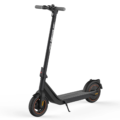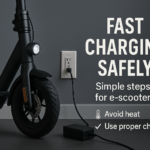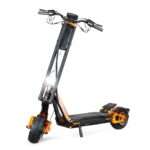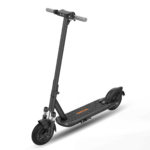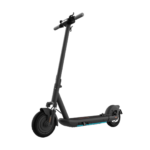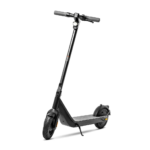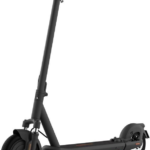- Home
- Scooters
- Electric Scooters
- INMOTION L8
INMOTION L8


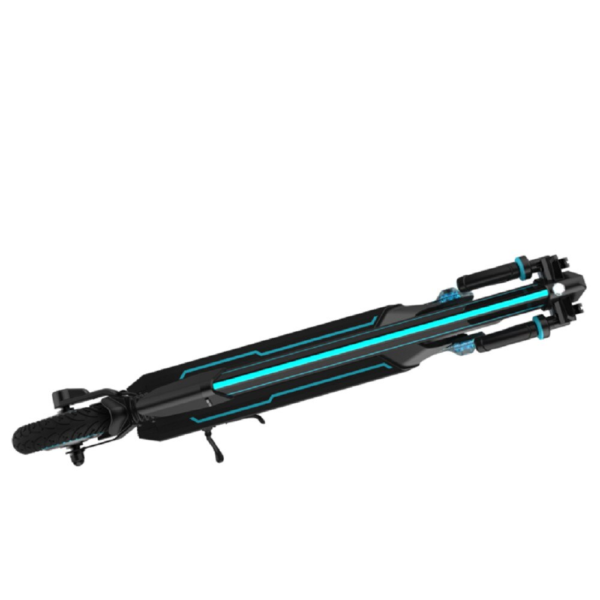
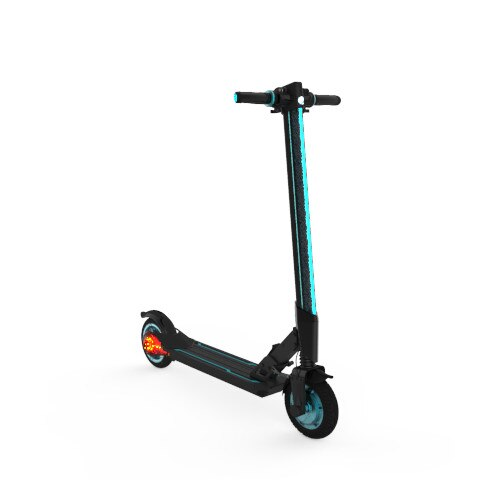
- Battery Range: 9.3 miles (15 km)
- Top Speed: 18.6 mph (30 km/h)
- Motor Power: 250 W
- Weight Capacity: 220 lb (100 kg)
- Charging Time: ~2.5 h
- Scooter Weight: 25.4 lb (11.5 kg)
PROS
- Very light 11.5 kg
- Compact overall size
- App functions including lock/lights
- IP54 rating
- Quick 2.5 h charge time
CONS
- Short 15 km range
- Lower 250 W power
- Mixed solid/pneumatic tires
- No suspension
Key Takeaways
- The INMOTION L8 is a lightweight, app-ready kick scooter designed for quick urban trips.
- It features a 250 W hub motor, a mix of solid and pneumatic tires, and a foldable design for easy transport.
- The battery offers around 9.3 miles of range and charges in approximately 2.5 hours.
- It’s ideal for commuters, students, and new riders who favor short distances and straightforward controls.
- While it’s great for flat routes, those needing to travel long distances or tackle steep hills might prefer a more powerful scooter.
Table of contents
- What Is the INMOTION L8?
- How the INMOTION L8 Works
- Key Specifications
- Design & Build Quality
- Performance Fundamentals
- Battery, Range & Efficiency
- Ride Quality & Comfort
- Braking & Safety Features
- Portability & Daily Usability
- Maintenance & Care
- Weather & Seasonal Considerations
- INMOTION L8 vs Alternatives
- Who the INMOTION L8 Is (and Isn’t) For
- FAQs
- Glossary
The INMOTION L8 is a compact, app-ready kick scooter for quick city trips. It keeps things light, simple, and easy to carry. So commuters, students, and first-time riders get a steady ride without much fuss. We lean on the official specifications to shape this guide, then add plain, real-world notes from a rider’s point of view.
What Is the INMOTION L8?
The INMOTION L8 is a light commuter scooter with two 8-inch wheels. The front tire is solid, so flats are rare. The rear tire is pneumatic, so bumps feel a bit softer. It runs a 36 V system with a 250 W hub motor for city speed limits. The deck is slim and the fold is quick. So stairs, train doors, and narrow halls feel doable. Weight sits around 25.4 lb (≈ 11.5 kg), which most adults can lift with one hand.
You can pair it to the INMOTION app for speed limits, lighting tweaks, and basic status checks. That keeps the cockpit clean. Then you keep the phone in your pocket and just ride. The focus is short hops and last-mile travel, not all-day range.
How the INMOTION L8 Works
Think of five pieces that work together. The motor is inside the wheel. The controller meters power. The battery stores energy. The throttle tells the system how much push you want. Then the brakes slow you down and feed a touch of energy back.
Motor and controller. A 250 W brushless hub motor pulls from the 36 V pack. The controller reads your thumb input and ramps current in a steady curve. So launches feel clean, not jumpy. Pull stays mild near the top of its range, which fits crowded streets.
Battery. The pack is 36 V and 4.4 Ah. That works out to about 158 Wh. You plug into a normal wall outlet. Charge time runs about 2.5 hours from low to full. Then a BMS balances the cells near the top, which helps them age more evenly.
Throttle. A thumb lever sets speed. Press a little for tight spaces. Press more when the lane opens. The mapping feels predictable, so you settle in fast.
Brakes. You get an electronic front brake and a rear foot brake. Tap the electronic control for gentle trims. Step on the fender when you want extra bite. Use both when traffic gets tight and you need a short stop.
Lights and display. A headlamp and tail lamp handle basic visibility. The decorative lights make your outline pop from the sides. A small LED display shows speed and battery bars. Then the app adds quick checks for settings, faults, and updates.
Key Specifications
Here is a clean list you can scan fast. Numbers are shown in both metric and imperial where it helps.
| Block | Item | Details |
|---|---|---|
| General | Model | INMOTION L8 |
| Net weight | ≈ 11.5 kg (25.4 lb) | |
| Max load | 100 kg (220 lb) | |
| App | INMOTION app over Bluetooth for lock, speed limit, lighting, status, and firmware updates | |
| Performance & Power | Factory max speed | 25 km/h (15.5 mph) |
| App-set max speed | ≈ 30 km/h (≈ 18.6 mph) | |
| Motor power | 250 W rated, 500 W peak | |
| Max gradient | ≈ 15° on short rises | |
| Battery, Charging & Electrical | Pack | 36 V, 4.4 Ah lithium (≈ 158 Wh) |
| Charging input | 100–240 V AC, 50–60 Hz | |
| Charging time | ≈ 2.5 hours to full | |
| Estimated range | ≈ 15 km (≈ 9.3 mi) under set test inputs | |
| Build & Dimensions | Overall (unfolded) | 1056 × 430 × 1100 mm (41.6 × 16.9 × 43.3 in) |
| Folded (approx.) | ≈ 1105 × 430 × 366 mm (≈ 43.5 × 16.9 × 14.4 in) | |
| Tire setup | 8-inch solid front, 8-inch pneumatic rear | |
| Safety & Control | Brakes | Electronic front brake with light regen feel, rear foot brake |
| Lighting | Headlamp, tail lamp, decorative lighting, handlebar lamp | |
| IP rating | IP54 | |
| Features & Extras | Display | LED screen with speed, battery, and Bluetooth |
| App features | Lock/unlock, speed limit, lights, fault check, updates | |
| Cruise Control | Not stated for this model | |
| Warranty & Compliance | Warranty | Terms vary by region and seller |
| Compliance | IP54 ingress protection listed |
That table covers the big stuff. So you can decide fast if the L8 fits your daily loop.
Design & Build Quality
The L8 looks tidy. The frame lines are simple and the deck is slim. Grip feels firm under soft-soled shoes. Then the straight stem locks with a quick lever, which makes folding a 5-second move once you get the hang of it.
Cables hug the stem and deck, so nothing snags on bags or jackets. Plastic housings cover the lights and display, and they sit tight without rattles on smooth ground. The kickstand flicks down cleanly and holds the scooter steady on flat pavement. The charging port sits forward with a cap that snaps shut. So splashy streets do not send water right into the connector.
Lighting is a highlight. The headlamp and tail lamp do the main work. The decorative glow helps cars and riders see your outline from the side. For example, an evening roll past a side street feels calmer when your deck glow catches attention a second earlier.
The battery lives in the deck and the motor sits in the wheel. This keeps the center of mass low. So steering feels calm in the mid-teens and the scooter tracks straight when you bend your knees over rough patches.
Performance Fundamentals
From 0 to about 10 mph the L8 is smooth. The throttle curve is friendly, which helps new riders get comfy fast. Then, on flat streets, it holds close to the set limit with a mid-weight rider.
On short hills near 7–10% grade, it slows a bit in the middle of the climb. That is normal for this power class. So carry some momentum into the base of the slope, and give it a steady thumb all the way up. The 500 W peak helps over the crest, yet this is still a light commuter, not a hill specialist.
Stability is calm in the mid-teens. The narrow deck invites a relaxed, staggered stance. You bend your knees and absorb chatter. The solid front tire keeps steering crisp on smooth concrete. Meanwhile, the rear pneumatic tire gives a small cushion over brick or coarse asphalt. That blend keeps the ride lively without beating you up.
The result is predictable. You get clean starts, easy speed control, and a capped top end that fits most city rules. So shared paths, bike lanes, and campus loops all feel natural.
Battery, Range & Efficiency
Range depends on a lot of things. Rider weight, wind, surface, temperature, and speed all matter. The listed range sits near 9.3 miles (≈ 15 km) using set lab inputs. Real life moves around that number. So plan with a little margin.
You can squeeze more distance from each charge with simple habits. Ride close to the factory speed cap when you can. That keeps current draw in a sweet spot. Keep the rear tire in good shape and at the right pressure. That cuts rolling losses. Then start smooth from stops, since hard bursts make heat and waste energy.
Charging from low to full takes about 2.5 hours. The pack is small, which is kind of the point. You top up during a break and you are back on the road fast. The wide input range means traveling between regions with similar plug shapes is simple, too.
If you will store the scooter for a while, leave the battery near half. Then top it to around 70–80% the night before your next long day. Cold trims range, and heat ages cells faster. So a cool, dry spot is your friend.
The L8 uses little energy per mile because it is light and not chasing big speeds. That keeps daily charging short and costs low.
Ride Quality & Comfort
The mixed-tire setup is the story. The solid front tire cannot pinch or puncture, which takes a worry off your list. It also passes a bit more buzz to your hands on rough concrete. Meanwhile, the rear pneumatic tire adds give for your knees and ankles. So you shift a touch more weight rearward when a block turns bumpy.
The stem feels straight and planted at city speeds. On old seams and pavers you feel a light buzz. Bend your knees and keep your elbows soft. Then small cracks pass under the deck without drama. For example, rolling across a metal plate at 10–12 mph feels firm but controlled.
Handlebar width is about 430 mm. That keeps you narrow in crowds and on buses. Grips are firm without being harsh. The brake and throttle sit close, which suits smaller hands. Then the LED display sits high enough to check battery bars without staring down.
Deck height leaves room for a natural stance with feet slightly offset. You can toe the rear fender for extra braking when traffic tightens. Riders with US men’s sizes up to around 12 still find stable footing without hanging toes.
Braking & Safety Features
The front electronic brake has a smooth curve. Tap to trim speed in a bike lane. Press more when you want a firmer slow-down. Then the rear foot brake adds a mechanical feel that shortens stopping distance. Using both together gives you your best stop when a car creeps into your lane.
Lighting fits neighborhood speeds. The headlamp covers the near field. The tail lamp helps drivers read your line. The side glow bumps visibility at four-way stops right around dusk. So crossing traffic catches you a little sooner.
The L8 lists an IP54 rating. That points to splash resistance and basic dust protection. You still avoid deep puddles. Then you dry the scooter after a wet ride and skip charging when the deck or port is damp. Those habits protect contacts and bearings.
App lighting presets and reflectors add to the plan. Pick a brighter look for short winter days. Then choose something calmer for crowded summer sidewalks.
Portability & Daily Usability
At roughly 25 lb the L8 is easy to carry for most adults. The fold is quick. Press the button, pull the lever, lower the stem until it clicks, then snap the bar clamp shut. After a day or two it feels automatic.
The folded package is about 14.4 in tall and 43.5 in long. That fits under many desks and behind a café table. You can store it upright against a wall with the kickstand down. Then a compact folding lock through the deck or a loop on the stem deters an opportunistic grab.
The app lock adds a soft layer against tampering. It does not replace a physical lock. So treat it as a deterrent and park in visible, well-lit spots when you can.
Daily routines are simple. Pop it open, quick check, ride. Close it up, set it down, plug in if needed. That is the appeal for quick urban loops.
Maintenance & Care
A light routine keeps the ride clean and safe.
Before each ride. Scan the rear tire. Spin both wheels and listen for rub. Check that the stem clamp is snug. Then tap the brake for a firm response. Glance at battery bars and pick a route that matches your charge.
Weekly. Wipe the deck and stem. Dust hides small issues and makes parts squeak. Check the kickstand pivot for play. Then open and close the folding latch to confirm it locks cleanly. Look at the rear fender’s brake surface and replace parts that look glazed or uneven.
Monthly. Inspect the front solid tire for cuts or flat spots. Inspect the rear tire for wear and punctures. Replace tubes or tires when cords show or nicks run deep. Then check the bar clamp and hinge screws for torque. Open the app and look for firmware updates or fault codes.
Charging habits. Plug in after rides that drop below roughly 30%. Unplug near full to reduce heat. Store around half if the scooter will sit. Then keep the charger and port dry and clean.
Consumables. The rear tire and tube wear first. The foot-brake surface scuffs and can glaze. Lights and the display usually just need a quick check for cracks after a tip-over.
Weather & Seasonal Considerations
Rain changes grip and sight lines. Slow earlier, ride smoother, and give yourself space. The deck grip helps, yet paint and metal are still slippery. Then dry the scooter after rides. Water pools near the stem hinge and the port. Wipe those areas first.
Cold trims range. Lithium cells sag a bit when they are chilly. So start with the scooter warm from indoors when you can. Ride easy for the first mile. Then the pack warms up and holds speed better.
Heat ages cells faster. Shade the scooter at stops. Do not leave it sealed in a hot car. Then let the pack rest for a few minutes before charging after a hard ride. That pause helps both the cells and the BMS.
Wind matters on a light scooter. A steady headwind feels like a small hill. So tuck your elbows and keep a steady pace to save energy and keep steering calm.
INMOTION L8 vs Alternatives
Light commuters tend to share the same outline. Under 30 lb. Top speed in the teens. Simple brakes. Modest battery. The L8 sits right in that lane.
Where the L8 shines. Size and weight lead the value story. You carry it with one hand, stash it under a desk, and pop it open in seconds. The split tire setup cuts flat risk up front and adds comfort in back. The app covers the basics without clutter. Then the lighting package makes you easier to see at dusk.
Where bigger commuters win. Larger scooters bring more battery and more punch. They climb longer hills with less fade. They use big pneumatic tires front and rear for a cushier ride. Then they weigh a lot more and take space on buses and in small apartments.
Where performance models win. Dual motors and big packs deliver strong launches and high top speeds. They stop shorter with large hydraulic discs and float over bad streets. Then you trade away portability and desk-side parking.
Two nearby options. Want a similar lightweight ride. Take a look at the INMOTION Air. Need more battery and a bigger platform. The INMOTION S1 targets longer commutes with a larger pack and roomier deck.
Who the INMOTION L8 Is (and Isn’t) For
Great fit. Multi-modal riders who link bus or train with short rides. Students who need quick campus hops. Apartment dwellers who carry up one or two flights. New riders who want easy controls and a steady learning curve. So confidence comes fast in that first week.
Maybe not ideal. Daily routes near 12 miles without places to charge. Long, steep hills every morning. Heavy loads on a small deck. Then a larger scooter with more battery and two pneumatic tires makes more sense.
Pick by route and storage. If your trips are short and mostly flat, the L8’s size and weight feel great. If your city throws hills at you, look at more power.
FAQs
How fast does the L8 go out of the box?
It caps near 15.5 mph (25 km/h). In the app you can lift the limit to about 18.6 mph (30 km/h) where rules allow. So you still ride in a commuter speed band.
What is the realistic range?
Plan for 6–10 miles on mixed routes. That assumes a mid-weight rider, mild wind, and steady speed near the factory cap. Then add margin for cold days and hills.
Can I ride in light rain?
The L8 lists IP54. That points to splash resistance for everyday use. You still avoid deep puddles. Then you dry the scooter after parking.
Does the INMOTION L8 have cruise control?
Cruise control is not stated here. So hold a steady thumb on the throttle when you want a fixed pace.
What tire sizes and types does it use?
Both are 8-inch. The front is solid. The rear is pneumatic. That mix keeps the steering low-maintenance and the rear a bit softer.
What about hill climbing?
Short rises near 7–10% are fine if you keep momentum. Long, steep hills are better on a bigger scooter with more motor power.
Where can I read an INMOTION L8 overview in one place?
Right here. This page packs the setup, care, and the core facts people ask about.
Glossary
Ah (amp-hours). Battery capacity. More Ah means more charge on tap.
Wh (watt-hours). Energy. Voltage times amp-hours.
Controller. The circuit that meters power from the pack to the motor.
Regen. Electronic braking that feeds a little energy back to the pack.
Stem flex. Movement you feel in the handlebar stem under load.
IP rating. Code that describes resistance to dust and water.
Hub motor. A motor built into the wheel hub.
Throttle. The control that tells the system how much power to send.
BMS. Battery management system that guards and balances cells.
Peak power. Short bursts above the rated motor number.
Pneumatic tire. Air-filled tire that adds grip and comfort.
Solid tire. No-air tire that avoids flats but rides firmer.
Kickstand. A strut that holds the scooter upright.
Deck grip. The textured surface that keeps your shoes planted.
Fold latch. The hinge that lets the stem collapse for storage.
Specifications
General
| Model The Model specifies the exact version or name of the scooter. It helps identify its unique design, features, and specifications within the manufacturer’s product line. Knowing the model makes it easier to compare options, find compatible accessories, or look up support information. | L8 |
| Brand The Brand identifies the manufacturer or company that designs and produces the scooter. A trusted brand is a sign of quality, reliability, and good customer support. Well-known brands often have higher standards for safety, performance, and after-sales service, giving you more confidence in your purchase. | INMOTION |
| Release Date The Release Date indicates when the scooter model was officially launched on the market. This helps you know how current the design, technology, and features are. A newer release date often means updated components, improved performance, and the latest safety or smart features. | 18 November 2025 |
| Recommended Age Recommended Age indicates the minimum age range that the scooter is designed for, based on safety, size, and ease of use. Following the recommended age helps ensure that riders can handle the scooter’s speed, weight, and controls comfortably and safely. Always check local laws and use protective gear, especially for younger riders. | +16 |
Performance & Power
| Motor Power (Wattage) What it means: The motor power, measured in watts (W), shows how strong the scooter’s electric motor is. Why it matters: Higher wattage usually means better acceleration, more torque, and improved performance on hills or rough terrain. For example, a 250W motor is good for flat city roads and light riders, while a 500W or 1000W motor provides more power for faster speeds or climbing steep inclines. | Front hub motor 250 W (500 W max) |
| Top Speed The Top Speed indicates the maximum speed that the scooter can reach under optimal conditions. It’s usually measured on level ground with a fully charged battery and an average rider weight. A higher top speed allows you to travel longer distances faster, but always ensure you ride within legal speed limits and your personal comfort zone for safety. | Approx. 18.6 mph (30 km/h) |
| Battery Capacity Battery Capacity refers to the total amount of energy the scooter’s battery can store, usually measured in ampere-hours (Ah) or watt-hours (Wh). A higher battery capacity means you can ride longer distances on a single charge, reducing the need for frequent recharging. Keep in mind that actual range can vary depending on rider weight, terrain, speed, and weather conditions. | 36 V 4.4 Ah (158 Wh) |
| Estimated Range per Charge The Estimated Range per Charge indicates the average distance the scooter can travel on a single full battery charge. This range is calculated under optimal conditions, such as flat terrain, moderate speed, and average rider weight. Real-world range may vary depending on riding style, terrain, weather, and load. A longer range means fewer recharges and greater freedom for longer trips. | 9.3 miles (15 km) |
| Hill Climb Ability Hill Climb Ability describes the maximum incline or slope that the scooter can handle while maintaining stable performance. It’s typically expressed as a percentage or in degrees. A higher hill climb rating means the scooter can tackle steeper hills without losing too much speed or power. Actual climbing performance may vary based on rider weight, battery charge, and terrain conditions. | Approx. 15° |
| Drive System The Drive System refers to how power from the motor is delivered to the wheels. Electric scooters typically use either a hub motor (directly integrated into the wheel) or a chain/belt drive system. A high-quality drive system ensures smooth acceleration, efficient power transfer, and low maintenance. The choice of drive system affects performance, noise level, and overall ride experience. | Front hub (FWD) |
Charging & Electrical
| Charging Time Charging Time indicates how long it takes to fully recharge the scooter’s battery from empty to 100% using the standard charger provided. Faster charging means less downtime and more time on the road. Actual charging time may vary slightly depending on battery capacity, charger output, and environmental conditions. | Approx. 2.5 hours |
| Battery Type Battery Type refers to the specific technology used in the scooter’s battery, which affects performance, lifespan, weight, and charging time. Most modern electric scooters use high-quality lithium-ion (Li-ion) batteries because they offer a good balance of energy density, durability, and low maintenance. A reliable battery type ensures consistent power delivery and longer riding ranges. | Lithium-ion pack |
| Removable Battery A Removable Battery means the battery pack can be easily detached from the scooter for convenient charging and replacement. This feature allows you to charge the battery separately, swap it with a spare for extended range, or securely store it indoors in extreme weather. Removable batteries add flexibility and make it easier to keep your scooter powered up wherever you are. | Non-removable internal battery (fixed pack) |
| Regenerative Braking Regenerative Braking is an energy-saving feature that converts some of the energy normally lost during braking back into battery power. When you slow down or brake, the motor works in reverse to generate electricity, which helps extend the scooter’s range and improves overall efficiency. This system also reduces wear on traditional brake components, leading to lower maintenance over time. | Yes (via electronic brake) |
| Lighting Lighting refers to the built-in front and rear lights that enhance visibility and safety when riding in low-light conditions or at night. Good lighting helps you see the road ahead and ensures that other road users can see you. Many scooters include LED headlights, taillights, and sometimes brake lights or side reflectors for added safety and compliance with local traffic regulations. | LED headlight. decorative RGB. rear light |
Build & Dimensions
| Scooter Weight Scooter Weight refers to the total weight of the scooter when fully assembled, including the battery. This affects how easy it is to carry, lift, and store the scooter when not in use. A lighter scooter is more portable and convenient for commuting, especially if you need to carry it upstairs or onto public transport. Keep in mind that a sturdy frame and quality components may add to the weight but also contribute to better durability and ride stability. | 25.4 lb (11.5 kg) |
| Maximum Rider Weight Maximum Rider Weight indicates the highest rider weight that the scooter is designed to safely support while maintaining optimal performance and stability. Staying within this limit helps ensure reliable acceleration, braking, and climbing ability, and it protects the frame, suspension, and motor from excessive strain. Exceeding the recommended limit may reduce performance and increase wear on components. | 220 lb (100 kg) |
| Deck Size Deck Size refers to the dimensions of the scooter’s standing platform. A wider and longer deck provides more foot space, allowing you to stand comfortably and adjust your stance while riding. A well-sized deck improves balance and stability, especially on longer rides or at higher speeds. Compact decks, on the other hand, help keep the scooter lightweight and portable. | Low, compact frame |
| Handlebar Height Handlebar Height refers to the distance from the deck to the handlebars, which affects your riding posture and comfort. An appropriate handlebar height helps you maintain good balance, reduces strain on your back and arms, and makes steering more comfortable. Some scooters have adjustable handlebars to fit riders of different heights, while others have a fixed height for a streamlined design. | Fixed |
| Folding Mechanism The Folding Mechanism describes how easily and securely the scooter can be folded for carrying and storage. A well-designed folding system lets you quickly collapse the scooter into a compact size, making it convenient to transport on public transit, store under a desk, or fit into a car trunk. Look for sturdy latches and safety locks to ensure the scooter stays firmly in place when folded or unfolded. | Folding latch with quick spanner |
| Dimensions Folded Dimensions indicate the size of the scooter when it’s fully folded. This measurement shows how much space the scooter will take up when stored or carried, making it easier to check if it will fit in your car trunk, under a desk, or in a closet. Compact folded dimensions are ideal for commuters who need to bring their scooter on public transport or store it in tight spaces. | Unfolded 41.6 × 16.9 × 43.3 in (1056 × 430 × 1100 mm). Folded: Not specified |
| Material Material refers to the primary construction materials used for the scooter’s frame and key components. High-quality materials like aircraft-grade aluminum, reinforced steel, or durable composites provide strength, stability, and a lighter overall weight. A sturdy material ensures the scooter can handle daily wear and tear while maintaining safety and performance. | Not specified |
Safety & Control
| Brake Type(s) Brake Type(s) describe the braking systems the scooter uses to help you slow down or stop safely. Common brake types include mechanical brakes (like drum or disc brakes), electronic brakes, and foot brakes. Many scooters combine multiple braking systems for added safety and shorter stopping distances. The type and quality of brakes affect your control, especially when riding at higher speeds or on slopes. | Electronic brake + rear foot brake |
| Suspension Suspension refers to the system that absorbs shocks and vibrations while riding, providing a smoother and more comfortable ride over uneven or rough surfaces. Scooters may have front suspension, rear suspension, or dual suspension for better shock absorption and stability. Good suspension helps reduce rider fatigue and improves control, especially when riding on bumpy roads or off-road paths. | None |
| Tire Type Tire Type refers to the kind of tires the scooter uses, which directly affects ride comfort, traction, and maintenance. Common types include solid (airless) tires, pneumatic (air-filled) tires, or hybrid options. Pneumatic tires offer better shock absorption and a smoother ride on rough surfaces, while solid tires are puncture-proof and require less upkeep. The right tire type helps ensure safe handling and a comfortable ride in different conditions. | 8″ front solid + 8″ rear pneumatic |
| Tire Size Tire Size indicates the diameter and width of the scooter’s tires, which affect ride comfort, stability, and how well the scooter handles different terrains. Larger tires generally offer better shock absorption and a smoother ride over bumps and rough surfaces, while smaller tires keep the scooter lighter and more portable. Choosing the right tire size helps ensure a balance between agility and comfort. | 8-inch |
| Kickstand The Kickstand is a built-in stand that allows you to park your scooter upright when it’s not in use. A sturdy kickstand keeps the scooter stable and prevents it from tipping over, protecting it from scratches and damage. It also makes storing and accessing your scooter more convenient, whether you’re at home, work, or on the go. | Side kickstand |
| Water Resistance Rating Water Resistance Rating indicates how well the scooter is protected against water and moisture, usually shown as an IP (Ingress Protection) rating. This rating helps you understand whether the scooter can handle light rain, splashes, or wet roads without damage. While most scooters are not fully waterproof, a good water resistance rating adds peace of mind when riding in changing weather conditions. Always avoid deep puddles or submerging the scooter to protect its electrical components. | IP54 |
Features & Extras
| Display/Console The Display (or Console) shows important real-time information about your ride, helping you monitor your scooter’s status at a glance. Typical displays show speed, battery level, distance traveled, and riding mode. Some models also include additional features like Bluetooth connectivity, app integration, or backlighting for better visibility at night. A clear and easy-to-read display enhances safety and convenience on every trip. | LED display with speed and battery |
| Ride Modes Ride Modes refer to the different speed and power settings you can choose to match your riding style or road conditions. Common modes include eco for maximum range and energy efficiency, standard for everyday balance, and sport or turbo for higher speed and stronger acceleration. Switching between ride modes allows you to customize performance, conserve battery, and ride safely in various environments. | 3 modes via app |
| Smart App Connectivity Smart App Connectivity lets you pair your scooter with a dedicated mobile app via Bluetooth. Using the app, you can monitor real-time ride stats like speed, battery level, and range, adjust settings such as ride modes or cruise control, lock the scooter for added security, and sometimes receive firmware updates. This feature adds convenience and allows you to personalize your riding experience right from your smartphone. | INMOTION App: lock, lights, settings |
| Anti-Theft System The Anti-Theft System helps protect your scooter from unauthorized use or theft. This feature can include built-in alarms, electronic motor locks, GPS tracking, or remote locking through a mobile app. A good anti-theft system provides peace of mind when parking your scooter in public spaces, adding an extra layer of security to safeguard your investment. | App lock |
| Cruise Control Cruise Control allows you to maintain a steady speed without continuously holding the throttle. This feature makes longer rides more comfortable by reducing hand fatigue and providing a smoother, more relaxed riding experience — especially on flat, open roads or bike lanes. For safety, cruise control can usually be easily activated or deactivated while riding. | Yes (cruise control) |
| Accessories Included Accessories Included lists the additional items that come with the scooter to enhance your riding experience and convenience. Common accessories may include a charger, kickstand, bell, lights, phone holder, or carrying strap. These extras add value by making your scooter safer, easier to use, and ready to ride straight out of the box. | Scooter, charger, user manual |
Warranty & Compliance
| Warranty Period The Warranty Period indicates how long the manufacturer guarantees the scooter against defects in materials and workmanship under normal use. A good warranty provides peace of mind, showing the brand’s confidence in its product quality. Always check what parts are covered, such as the frame, battery, and motor, and follow the maintenance guidelines to keep your warranty valid. | 12 months (region-dependent) |
| Certifications Certifications confirm that the scooter meets specific safety, quality, and environmental standards set by recognized organizations or regulatory bodies. Common certifications may include CE, RoHS, UL, or other local compliance marks, depending on your region. These certifications ensure that the scooter is manufactured to high standards and is safe and legal to use in your country. | Local micromobility compliance |



